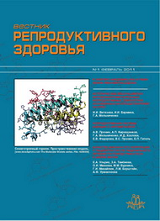
The scientific peer-rewieved medical journal "Bulletin of Reproductive Health" is issued since 2007. Publishes original articles about the carried-out clinical, experimental and fundamental scientific works, reviews, lectures, descriptions of clinical cases, debatable materials, transfers of the foreign periodic medical press, and also auxiliary materials on all actual problems of reproductive medicine.
The main subject of the journal is focused on key questions of reproductive health, etiology and pathogenesis of various reproductive system diseases, features of their clinical picture. And also to diagnostics and treatment of violations of a sexual differentiation, problems of fruitless marriage, auxiliary reproductive technologies, climacteric frustration...
The priority direction of the journal is acquaintance of a wide range of experts and healthcare providers with world tendencies of reproductive medicine, and also an assessment of emergence of the latest and perspective methods of treatment and prevention of diseases from a position of evidential medicine.
The journal:
acquaints readers with the original domestic and foreign researches reflecting development of world reproductive medicine;
issues the thematic numbers devoted to the separate directions (violations of formation of a floor, infertility, SPKYa, klimakteriya, replaceable hormonal therapy, pregnancy and diabetes...);
publishes the chronicle of the major international congresses and symposiums on reproductive medicine, and also the latest international and national clinical recommendations and consensuses;
is intended for scientists, obstetricians-gynecologists, endocrinologists, and also experts of all adjacent specialties, including urologists, general practitioners, family doctors, pediatricians, and other experts.
Federal Supervision Agency for Information Technologies and Communications registration ПИ № ФС77-26540 from 15.12.2006.
Current issue
NEWS
CLINICAL GUIDELINES
REVIEWS

This work is licensed under a Creative Commons Attribution-NonCommercial-NoDerivatives 4.0 International License (CC BY-NC-ND 4.0).




















